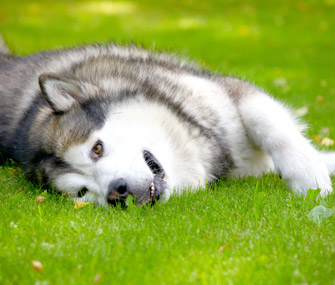Can Cold-Weather-Loving Dog Breeds Be Happy in Hot Climates?
Published on December 01, 2014
Skip To

Q. My dream breed is an Alaskan Malamute, but we
live in south Florida. Would it be wrong to make a breed like the Malamute live
in our hot, humid environment? We have air conditioning, of course, but is that
enough?
A. This is a common problem: wanting (or having) a
dog who’s not quite right for your climate or home environment. Sometimes the
right decision is to wait until your circumstances are different, but if you’re
willing and able to take some precautions and make smart decisions about
the dog’s lifestyle, I don’t see why you can’t successfully live with a
Malamute or any other snow-loving breed, such as a Siberian Husky, Akita, Saint
Bernard, Norwegian Elkhound, Newfoundland or Finnish Lapphund — even if you call Florida home. Here are some tips to help northern dogs chill out in the heat. Some other breeds, including Bulldogs, Boston Terriers, Boxers, Bullmastiffs, Chinese Shar-Pei, Dogues de Bordeaux, French Bulldogs, Japanese Chin, Pekingese and Pugs, are also sensitive to heat, and this advice applies to them as well.
Keep Your Canine Cool
Avoid the outdoors during the day. Of course, your dog
can go out for potty breaks, but you’ll probably find that he comes back in as
soon as possible. Malamutes and other cold-weather breeds would rather be outdoors on cool mornings and evenings, so
schedule walks and playtime for those hours. As a rule, limit strenuous activity when the temperature is
70 degrees or higher, though. It may not seem hot to you, but you’re not wearing a
fur coat. Go for two or three short walks instead of one long walk. If it’s hot in the evening, too, play indoors.
Provide mental exercise, such as nose work practice, throw a squeaky toy
down the hall, or teach him to walk on a treadmill.Create cool zones around your home. If your dog has access to the outdoors during the day, provide him with a kiddie pool filled with cool water where he can lounge. He may also dig himself a nice, cool hole beneath a tree. If necessary, provide shade with a sun-protective tarp or deck cover. Your dog will want a cool place to sleep indoors, too. If you don’t have a wood or tile floor, position a fan near his favorite napping area. And always put safety first: If you have an in-ground pool, your furry friend may love to splash around in it, but it’s important to make sure he knows how to swim — and how to get out of the pool. All that fur can weigh him down when it gets wet. If you’re not home to supervise, your dog shouldn’t have access to the pool.
Be alert when you’re out and about. At parks, choose a spot in the shade and be sure you have a cooling mat for your dog to lie on and plenty of fresh water for him to drink. A cooling vest can also be helpful if your dog has a dark coat or will be walking around on a warm day. Carry a spray bottle filled with cool water so you can mist him periodically. When you and your dog are driving in the car, keep him cool with a crate fan in addition to running the air conditioner and never leave your dog in the car on a sunny day.
Offer cold drinks and snacks. Take a water bottle on walks. I like one that has a bowl that folds out to make it easy for the dog to drink. Use water dishes that you can put in the freezer to help keep water cooler longer or put ice cubes in your dog’s water dish. You can offer him frozen treats, too. Put some of your dog’s favorite goodies inside an empty cardboard milk carton, fill it with water, and freeze. Then peel off the cardboard and let your dog play with the “pupsicle” outdoors.
Keep fur under control. Brush your dog regularly to remove excess hair, but I don’t believe in shaving his coat down to the skin. The outer- and undercoat insulate him from heat as well as cold and protect his skin from sunburn. Shaving it isn’t a kindness. A dog with a thick, heavy coat is also going to be extra miserable if he’s attacked by fleas and other parasites. Put him on good parasite preventives year-round, so he’s protected against fleas and ticks as well as heartworms and intestinal worms.
Watch his weight. Keep him at a normal weight, preferably on the thin side. Obese dogs are more sensitive to heat and humidity.
More on Vetstreet.com:
- 10 Dog Breeds That Love Cold Weather
- Most Popular Puppy Names of 2014
- Do Dogs Need Sweaters or Coats? Only 3 Types Do

